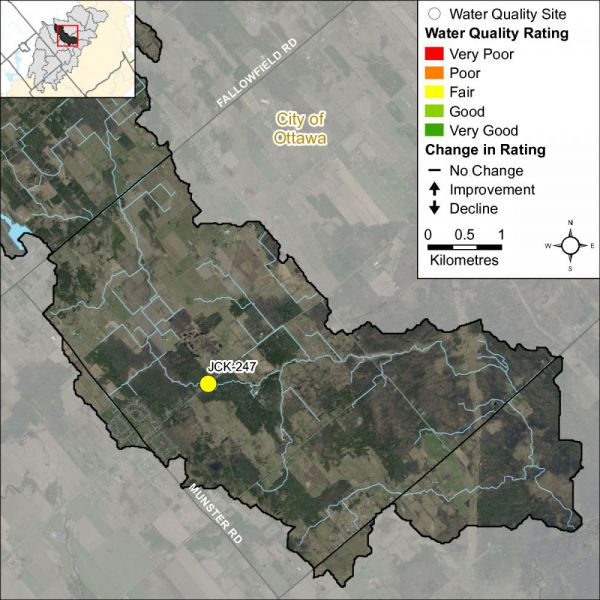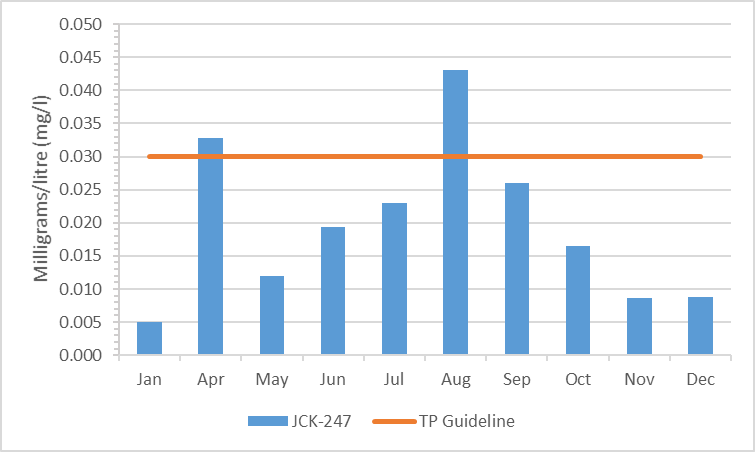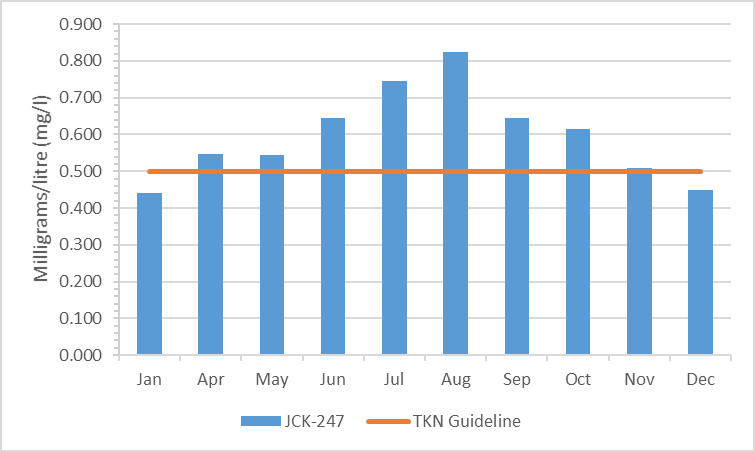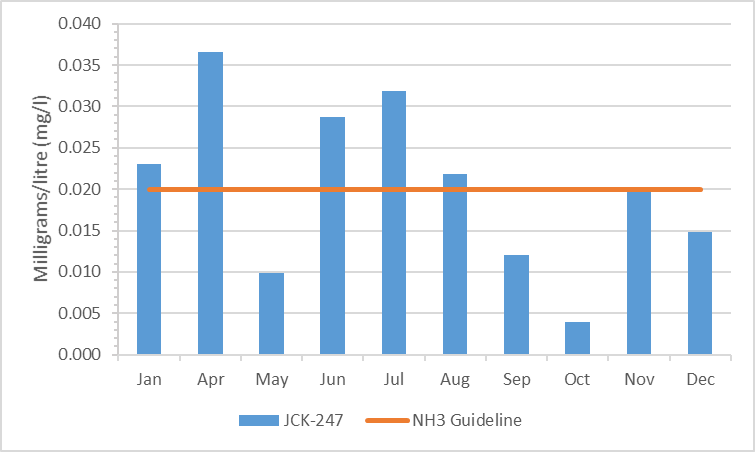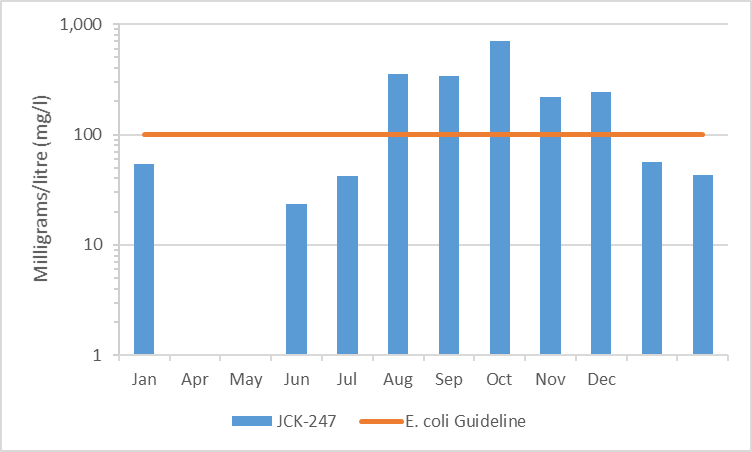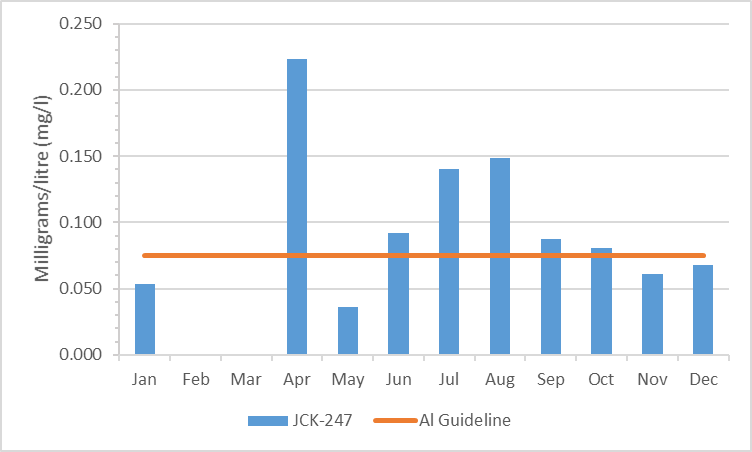2.0 Hobbs Drain Catchment: Surface Water Quality Conditions
Surface water quality conditions in the Hobbs Drain Catchment are monitored by the City of Ottawa Baseline Water Quality Monitoring Program. This program provides information on the condition of Ottawa’s surface water resources; data is collected for multiple parameters including nutrients (total phosphorus, total Kjeldahl nitrogen and ammonia), E. coli, metals (like aluminum and copper) and additional chemical/physical parameters (such as alkalinity, chlorides, pH and total suspended solids). The locations of monitoring sites are shown in Figure 2 and Table 1.
2.1 Hobbs Drain Water Quality Rating
The RVCA's water quality rating for Hobbs Drain (site JCK-247) is “Fair” (Table 1) as determined by the Canadian Council of Ministers of the Environment (CCME) Water Quality Index. A “Fair” rating indicates that water quality is usually protected but is occasionally threatened or impaired; conditions sometimes depart from natural or desirable levels. Each parameter is evaluated against established guidelines to determine water quality conditions. Those parameters that frequently exceed guidelines are presented below. There is limited data available at this site prior to 2010, therefore only information for the 2010-2015 period will be discussed. Table 1 shows the overall rating for the monitored surface water quality site within the Hobbs Drain Catchment and Table 2 outlines the Water Quality Index (WQI) scores and their corresponding ratings.
There is one monitored water quality site on Hobbs Drain within this catchment (JCK-247, Figure 2). The score at this site is largely influenced by occasional high nutrient concentrations, bacterial pollution and metal (aluminum) exccedances. For more information on the CCME WQI, please see the Jock River Subwatershed Report.
| Sampling Site | Location | 2004-2009 | Rating |
|---|---|---|---|
| JCK-247 | Hobbs Drain upstream of Bleeks Rd. bridge north east of Battlefield Rd. | NA | NA |
| Sampling Site | Location | 2010-2015 | Rating |
| JCK-247 | Hobbs Drain upstream of Bleeks Rd. bridge north east of Battlefield Rd. | 78 | Fair |
| Rating | Index Score |
|---|---|
| Very Good (Excellent) | 95-100 |
| Good | 80-94 |
| Fair | 65-79 |
| Poor (Marginal) | 45-64 |
| Very Poor (Poor) | 0-44 |
2.2 Nutrients
Total phosphorus (TP) is used as a primary indicator of excessive nutrient loading and may contribute to abundant aquatic vegetation growth and depleted dissolved oxygen levels. The Provincial Water Quality Objective (PWQO) is used as the TP Guideline and states that in streams concentrations greater than 0.030 mg/l indicate an excessive amount of TP.
Total Kjeldahl nitrogen (TKN) and ammonia (NH3) are used as secondary indicators of nutrient loading. RVCA uses a guideline of 0.500 mg/l to assess TKN[1] and the PWQO of 0.020 mg/l to assess NH3 concentrations in the Jock River.
Tables 3, 4 and 5 summarize average nutrient concentrations at monitored sites within the Hobbs Drain catchment and show the proportion of results that meet the guidelines.
| Total Phosphorous 2010-2015 | |||
|---|---|---|---|
| Site | Average (mg/l) | Below Guideline | No. Samples |
| JCK-247 | 0.020 | 84% | 51 |
| Total Kjeldahl Nitrogen 2010-2015 | |||
|---|---|---|---|
| Site | Average (mg/l) | Below Guideline | No. Samples |
| JCK-247 | 0.610 | 25% | 51 |
| Ammonia 2010-2015 | |||
|---|---|---|---|
| Site | Average (mg/l) | Below Guideline | No. Samples |
| JCK-247 | 0.020 | 63% | 51 |
Monitoring Site JCK-247
TP results rarely exceeded the PWQO at site JCK-247. Eighty-four percent of samples were below the guideline (Figure 3). The average TP concentration was below the objective at 0.020 mg/l as shown in Table 3.
The bulk of TKN results were elevated (Figure 4); only 25 percent of samples were below the guideline in the 2010-2015 period. The average concentrations exceeded the guideline at 0.610 mg/l (Table 4).
The results for NH3 indicate that exceedances occurred occasionally. Sixty-three percent of results were below the guideline in 2010-2015 reporting period (Figure 5). The average NH3 was 0.020 mg/l and just meets the PWQO (Table 5).
Summary
Occasional nutrient enrichment is a feature in this reach of Hobbs Drain. The elevated TKN concentrations and moderate NH3 results provide evidence that elevated nutrients may be a natural feature in this part of the drain. Occasional exceedances of both NH3 and TP indicate that some nutrient loading may occur from upstream anthropogenic sources such as fertilizer use, agricultural activities and storm water runoff. Elevated nutrients may result in nutrient loading downstream and to the Jock River. High nutrient concentrations can help stimulate the growth of algae blooms and other aquatic vegetation in a waterbody and deplete oxygen levels as the vegetation dies off. Best management practices (i.e. buffered shorelines, maintianing native shoreline vegetation, restricting livestock access to surface water, etc) should be employed wherever possible to limit nutrient loading to the waterbody.
2.3 Escherichia coli
Escherichia coli (E. coli) is used as an indicator of bacterial pollution from human or animal waste; in elevated concentrations it can pose a risk to human health. The PWQO of 100 colony forming units/100 millilitres (CFU/100 ml) is used. E. coli counts greater than this guideline indicate that bacterial contamination may be a problem within a waterbody.
Table 6 summarizes the geometric mean[2] for the monitored site on the Hobb’s Drain and shows the proportion of samples that meet the E. coli guideline of 100 CFU/100 ml. The results of the geometric mean with respect to the guideline in the 2010-2015 period is shown in Figure 6.
| E. coli 2010-2015 | |||
|---|---|---|---|
| Site | Geometric Mean (CFU/100ml) | Below Guideline | No. Samples |
| JCK-247 | 130 | 33% | 51 |
Monitoring Site JCK-247
Elevated E. coli counts at site JCK-247 were a common occurrence. The proportion of samples below the guideline was 33 percent (Figure 6). The geometric mean was 130 CFU/100ml (Table 6), and exceed the PWQO of 100 CFU/100ml.
Summary
Bacterial pollution appears to be a concern at this site, the count at the geometric mean exceeds the PWQO and the majority of samples exceed the guideline. Best management practices such as enhancing shoreline buffers, minimizing storm water runoff and restricting livestock access to creeks can help to protect this reach of Hobbs Drain into the future.
2.4 Metals
Of the metals routinely monitored in Hobbs Drain Catchment, aluminum (Al) occasionally reported concentrations above the PWQO. In elevated concentrations metals can have toxic effects on sensitive aquatic species.
Table 7 summarizes metal concentrations at sites JCK-247 as well as show the proportion of samples that meet guidelines. Figure 7 shows metal concentrations with respect to the guideline (PWQO) of 0.075 mg/l.
| Aluminum 2010-2015 | |||
|---|---|---|---|
| Site | Average (mg/l) | Below Guideline | No. Samples |
| JCK-247 | 0.100 | 56% | 50 |
Monitoring Site JCK-247
The average Al concentration of 0.100 mg/l at site JCK-247 exceeded the guideline (Table 7). The majority of samples (56 percent) were below the guideline (Figure 7) from 2010-2015.
Summary
In the Hobbs Drain catchment aluminum concentrations often exceed the PWQO. The most elevated concentrations are observed during the spring likely due to increased runoff amounts from melt conditions, efforts should continue to be made to identify pollution sources and implement best management practices to reduce any inputs (such as storm water runoff, metal alloys, fungicides and pesticides) to improve overall stream health and lessen downstream impacts.
1 No Ontario guideline for TKN is presently available; however, waters not influenced by excessive organic inputs typically range from 0.100 to 0.500 mg/l, Environment Canada (1979) Water Quality Sourcebook, A Guide to Water Quality Parameters, Inland Waters Directorate, Water Quality Branch, Ottawa, Canada
2 A type of mean or average, which indicates the central tendency or typical value of a set of numbers by using the product of their values (as opposed to the arithmetic mean which uses their sum). It is often used to summarize a variable that varies over several orders of magnitude, such as E. coli counts
